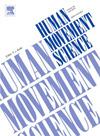A temporal quantitative analysis of visuomotor behavior during four twisting somersaults in elite and sub-elite trampolinists
IF 1.9
3区 心理学
Q4 NEUROSCIENCES
引用次数: 0
Abstract
Vision has previously been correlated with performance in acrobatic sports, highlighting visuomotor expertise adaptations. However, we still poorly understand the visuomotor strategies athletes use while executing twisting somersaults, even though this knowledge might be helpful for skill development. Thus, the present study sought to identify the differences in gaze behavior between elite and sub-elite trampolinists during the execution of four acrobatics of increasing difficulty. Seventeen inertial measurement units and a wearable eye-tracker were used to record the body and gaze kinematics of 17 trampolinists (8 elites, 9 sub-elites). Six typical metrics were analyzed using a mixed analysis of variance (ANOVA) with the Expertise as inter-subject and the Acrobatics as intra-subject factors. To complement this analysis, advanced temporal eye-tracking metrics are reported, such as the dwell time on areas of interest, the scan path on the trampoline bed, the temporal evolution of the gaze orientation endpoint (SPGO), and the time spent executing specific neck and eye strategies. A significant main effect of Expertise was only evidenced in one of the typical metrics, where elite athletes exhibited a higher number of fixations compared to sub-elites (p = 0.033). Significant main effects of Acrobatics were observed on all metrics (p < 0.05), revealing that gaze strategies are task-dependent in trampolining. The recordings of eyes and neck movements performed in this study confirmed the use of “spotting” at the beginning and end of the acrobatics. They also revealed a unique sport-specific visual strategy that we termed as self-motion detection. This strategy consists of not moving the eyes during fast head rotations, a strategy mainly used by trampolinists during the twisting phase. This study proposes a detailed exploration of trampolinists' gaze behavior in highly realistic settings and a temporal description of the visuomotor strategies to enhance understanding of perception-action interactions during the execution of twisting somersaults.
对精英和次精英蹦床运动员在四个扭转筋斗中的视觉运动行为进行时间定量分析。
视觉以前曾与杂技运动中的表现相关联,突显了视觉运动专业知识的适应性。然而,我们对运动员在执行扭转筋斗时使用的视觉运动策略仍然知之甚少,尽管这些知识可能有助于技能的发展。因此,本研究试图找出精英蹦床运动员和次精英蹦床运动员在执行四个难度递增的杂技动作时的注视行为差异。研究人员使用 17 个惯性测量单元和一个可穿戴眼动追踪器记录了 17 名蹦床运动员(8 名精英,9 名亚精英)的身体和目光运动学数据。采用混合方差分析(ANOVA)对六项典型指标进行了分析,其中 "专业技能 "为受试者间因素,"杂技 "为受试者内因素。为补充这一分析,还报告了先进的时间眼动追踪指标,如在感兴趣区域的停留时间、在蹦床上的扫描路径、注视方向终点(SPGO)的时间演变以及执行特定颈部和眼动策略所花费的时间。只有在其中一项典型指标中,"专长 "产生了明显的主效应,即精英运动员的固定次数高于亚精英运动员(p = 0.033)。杂技在所有指标上都有显著的主效应(p
本文章由计算机程序翻译,如有差异,请以英文原文为准。
求助全文
约1分钟内获得全文
求助全文
来源期刊

Human Movement Science
医学-神经科学
CiteScore
3.80
自引率
4.80%
发文量
89
审稿时长
42 days
期刊介绍:
Human Movement Science provides a medium for publishing disciplinary and multidisciplinary studies on human movement. It brings together psychological, biomechanical and neurophysiological research on the control, organization and learning of human movement, including the perceptual support of movement. The overarching goal of the journal is to publish articles that help advance theoretical understanding of the control and organization of human movement, as well as changes therein as a function of development, learning and rehabilitation. The nature of the research reported may vary from fundamental theoretical or empirical studies to more applied studies in the fields of, for example, sport, dance and rehabilitation with the proviso that all studies have a distinct theoretical bearing. Also, reviews and meta-studies advancing the understanding of human movement are welcome.
These aims and scope imply that purely descriptive studies are not acceptable, while methodological articles are only acceptable if the methodology in question opens up new vistas in understanding the control and organization of human movement. The same holds for articles on exercise physiology, which in general are not supported, unless they speak to the control and organization of human movement. In general, it is required that the theoretical message of articles published in Human Movement Science is, to a certain extent, innovative and not dismissible as just "more of the same."
 求助内容:
求助内容: 应助结果提醒方式:
应助结果提醒方式:


